If you’re feeling a little rusty in the social skills department these days, you are not alone. In fact, there’s a name for it: post-pandemic reentry anxiety.
It may take you some time to wrap your head around returning to face-to-face working conditions - or even a mix of office and remote work - after more than a year of remote work. Indeed, in February of this year, as promising light appeared at the end of this pandemic tunnel, U.S. adults reported their highest stress levels since the earliest days of the Covid-19 crisis, according to a survey by the American Psychological Association.
Of course, the softer skills of management, relationship building, communication, and collaboration are more critical than ever.
If you find you need a little remedial people skills training, take heart: We’ve gathered 10 great books to consider, several of which address the additional challenges of ongoing remote or hybrid interactions.
1. Better Small Talk: Talk to Anyone, Avoid Awkwardness, Generate Deep Conversations, and Make Real Friends
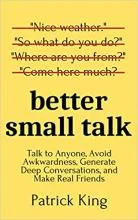
by Patrick King
Book description (via Amazon): “What to say and when to say it to be likable, connect, and make a memorable impression. Actionable and applicable verbal maneuvers for just about every phase of conversation. From hello to goodbye, with strangers or old friends, you’ll learn how to simply go deeper. NO MORE: interview mode, awkward silence, or struggling to hold people’s attention. Learn better small talk to avoid awkwardness, put people at ease, and build real rapport.”
Why you should read it: Some IT leaders and managers welcomed the (temporary) end to pre-meeting chit-chat and watercooler confabs that the pandemic has offered. But the moratorium on small talk has been lifted. Social skills coach King leans on a variety of sources, including scientific research, academic experience, coaching, and his own experience as a self-described introvert for this conversational how-to. He offers sample dialogues, responses, phrases, and questions to use to make small talk less of a big deal.
[ Working on your communication skills? Read also: 9 must-read books to make you a stronger communicator. ]
2. Reset: A Leader’s Guide to Work in an Age of Upheaval

by Johnny C. Taylor Jr.
Book description (via the Society for Human Resource Management (SHRM): “With the growth of remote work and an increased focus on diversity and inclusion, companies are increasingly finding themselves in “wars for talent” as they source and recruit candidates from all over the world. They need to find new ways to contact people and new sources of talent. They need to create an enduring and tangible culture that helps everyone feel empowered to do their best work. And they need to develop inclusive organizations that leverage differences for growth and innovation.
Informed by more than 70 years of experience and expertise and propelled by extensive original SHRM research, Reset delivers a candid and forward-thinking vision for leaders to reimagine their company cultures in a time of global upheaval.”
Why you should read it: Great people skills begin with selecting the best people. SHRM CEO and President Taylor offers a call to action to transform the way leaders select, retain, and train employees in a business environment radically remade. Beyond delivering a rousing argument, Taylor also offers strategies and tools for finding and keeping the right talent long term.
3. 120 Difficult Conversations to Have With Employees: How a Manager Should Discuss Performance, Inappropriate Conduct, and Common Work Situations
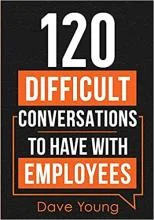
by Dave Young
Book description (via Amazon): “No matter what your situation is, dealing with some type of conflict always gives way to anxiety and fear — prompting us to ask questions like ‘What if I offend them?’, ‘What if they take it the wrong way?’, or ‘What if they get mad at me?’
All these WHAT Ifs are very valid questions to ask. Difficult conversations have always been a challenge, no matter how confident, tactful, or courageous a person may be. However, addressing difficult issues properly is always the key that opens the door to a resolution — especially in the workplace. It’s a necessity that goes with the territory of being a person who interacts with others daily.
In this helpful resource, managers will learn how to discuss performance, inappropriate conduct, and other common work situations. Employees will able be able to learn from the insights on how to approach difficult situations with their colleagues or their bosses.”
Why you should read it: Consider this an encyclopedia for tough talks. This reference book covers a plethora of situations in a clear Q&A format, covering topics including employee behavioral issues and termination, workplace politics, crisis communications, and morale management.
4. How to Deal With Difficult People: Learn to Get Along With People You Can’t Stand, and Bring Out Their Best
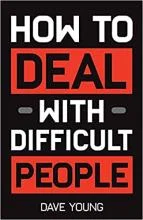
by Dave Young
Book description (via Amazon): “Difficult people can be insanely hard to deal with, and if you have to deal with them regularly, it may really be quite trying on your mental health and your overall sense of wellbeing.
The main problem is that you can’t avoid them – the world is full of them. That’s why you need to learn how to deal with them in the most painless way possible.”
Why you should read it: Once you’ve mastered the difficult conversations, go back to Young for pointers on dealing with the negative personalities in your work orbit. The author offers some counterintuitive advice on recognizing the difficult people in your surroundings (hint: they’re not always the ones you think they are), coping strategies, advice for bringing out the best in yourself and others, and a workplace-specific guide to the topic. Bonus: There are seven other guides for dealing with difficult folks (kids included!) in your household, family, and community.
5. Conflict at Work: A Toolkit for Managing Your Emotions for Successful results

Book description (via Amazon): “Unresolved conflicts will fester, making work miserable, derailing your career and sabotaging your business.
You deserve better. You can get the results you need and want and strengthen relationships.
This book will provide you with a buffet of tools. Instead of force-fitting yourself into one uncomfortable approach, you can pick and choose and combine the tools in a way that works for you.”
Why you should read it: Dr. Daoust, a behavioral psychologist who helps clients manage their work issues, published this book last fall to help others deal with workplace conflict. Individuals who don’t understand how to navigate differences often end up demanding what they want and ruining relationships or avoiding disagreements and limiting their success.
Dr. Daoust offers tools for turning adversaries into allies, resolving issues before they reach a boiling point, maintaining calm and confidence when managing differences, and building a reputation for being the go-to person for getting things done.
6. HBR’s 10 Must Reads on Communication, Vol. 2
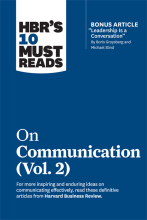
By Harvard Business Review
Book description (via Harvard Business Press): “Is your message getting through? The right communication tactics can motivate your people–and fuel your business.
We’ve combed through hundreds of Harvard Business Review articles and selected the most important ones to help you get your message across — whether you’re speaking face-to-face or connecting with someone across the world.”
Why you should read it: Get the timeliest HBR communication articles in one dose from leading experts including Erin Meyer, Heidi Grant, and Douglas Stone. This book covers the gamut of communication, from face-to-face to digital to data story-telling. Articles include: “Leadership Is a Conversation” by Boris Groysberg and Michael Slind, as well as “The Surprising Power of Questions,” “A Second Chance to Make the Right Impression,” “The Art of Giving and Receiving Advice,” “Find the Coaching in Criticism,” “Visualizations That Really Work,” “What Managers Need to Know About Social Tools,” “Be Yourself, But Carefully,” “How to Preempt Team Conflict,” “Getting to Si, Ja, Oui, Hai, and Da,” and "Cultivating Everyday Courage.”
7. How to Listen with Intention: The Foundation of True Connection, Communication, and Relationships

by Patrick King
Book description (via Amazon): “In this day and age, the art of deep listening is a superpower. If you can make someone feel heard and important, you are on the highway to their heart. And it’s not as difficult or complex as you think.
How to Listen with Intention is ultimately a book about relationships. A relationship must be give-and-take. Are you taking more than you are giving? Are you making people feel comfortable opening up to you? Are you listening well, or unwittingly being a conversational/relationship narcissist?”
Why you should read it: It’s social skills coach King again, this time focusing on increasing the critical emotional intelligence capability of listening. Here, he offers coaching on how to understand what is happening behind people’s words, the worst mindsets for listening, and how to master active and reflective listening.
8. Think Again: The Power of Knowing What You Don’t Know
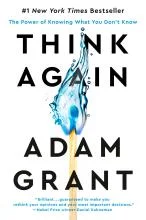
by Adam Grant
Book description (via Wharton School Press): “Intelligence is usually seen as the ability to think and learn, but in a rapidly changing world, there’s another set of cognitive skills that might matter more: the ability to rethink and unlearn. In our daily lives, too many of us favor the comfort of conviction over the discomfort of doubt. We listen to opinions that make us feel good, instead of ideas that make us think hard. We see disagreement as a threat to our egos, rather than an opportunity to learn. We surround ourselves with people who agree with our conclusions, when we should be gravitating toward those who challenge our thought process. The result is that our beliefs get brittle long before our bones. We think too much like preachers defending our sacred beliefs, prosecutors proving the other side wrong, and politicians campaigning for approval–and too little like scientists searching for truth. Intelligence is no cure, and it can even be a curse: being good at thinking can make us worse at rethinking. The brighter we are, the blinder to our own limitations we can become.”
Why you should read it: Mindset may seem a bit far afield from people management. However, this classic book from organizational psychologist Grant underscores the positive impact that arguing like you’re right, but listening like you’re wrong can have on business relations and outcomes. Employing his usual evidence-backed, narrative-fueled approach, Grant explains the wisdom of knowing what we don’t know and the benefits of being wrong.
9. Leaders Deserve Better: A Leadership Development Revolution
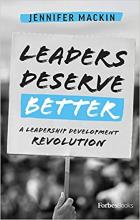
by Jennifer Mackin
Book description (via Amazon): “The vast majority of leadership development programs don’t work. Not only do they feel irrelevant―failing to address the issues that keep leaders up at night―even when they are on point, without built-in opportunities for leaders to practice what they’ve learned, those lessons don’t stick. To cultivate better leaders―ones who can serve as the next generation of senior management, bring business to new heights, and stay with the organization long enough to create lasting change― we need a better solution. Leaders Deserve Better is that solution.
Relying on her experience working with leaders, Jennifer Mackin begins by laying out the problem with standard development practices using real-life examples that illustrate the impact of inadequate development. She gives readers a glimpse of the myriad benefits of a better―and entirely revolutionized―approach, offering tools for leaders to conduct their own assessments to discover the gaps in their programming.”
Why you should read it: You may have missed this manifesto on modern leadership development when it came out last summer. It’s worth a look for this leadership development coach’s take on the problems with outmoded leadership development programs and her four-part prescription for doing it better (including aligning leadership development with strategy).
10. Millennials’ Guide to Management & Leadership: What No One Ever Told you About How to Excel as a Leader
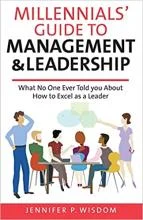
by Jennifer P. Wisdom
Book description (via Amazon): “In our 20s and 30s, once we learn the basics of navigating the world of work, many of us start moving into management and leadership positions. Today’s Millennials are also still striving to identify who they are, what they want, and how to get it. “Millennials’ Guide to Management and Leadership” helps Millennials launch to become skilled managers and leaders who are prepared to tackle the complex problems of the future.”
Why you should read it: Millennials already in management positions can take a page (or a couple hundred) from clinical psychologist and consultant Wisdom, who spent two decades working with this workforce generation at Columbia University and George Washington University. A follow up to Millennials’ Guide to Work, this book offers practical tips for the newest cohort of IT leaders on becoming respected, successful, and effective in increasingly powerful roles, including the challenges of managing up and down.
[ Where is your team's digital transformation work stalling? Get the eBook: What's slowing down your Digital Transformation? 8 questions to ask. ]





